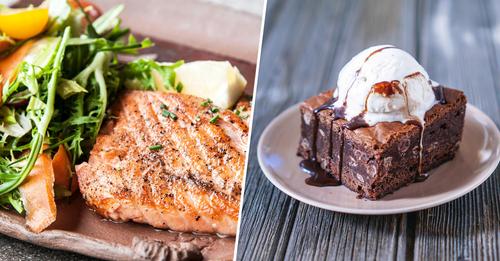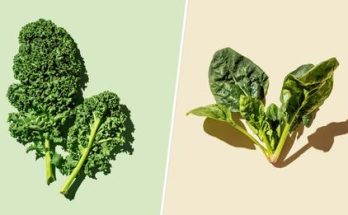The 80/20 rule is a simple, flexible approach to eating that encourages balanced, nutritious eating 80% of the time and eater’s choice — or foods that may be less healthy — 20% of the time. When dietitians recommend balanced eating, it can sound vague and unhelpful. So, the 80/20 rule offers more specific guidance without any rigid food rules or unnecessary food restrictions.
If you like the idea of helping yourself to a cookie after lunch or a cocktail at happy hour while maintaining a nutritious diet, the 80/20 philosophy might be a good option. Here’s how it works and how to determine if it’s the right fit for you.
80/20 rule: Here’s what to eat 80% of the time
The healthiest eating pattern is rooted in whole foods, with plants dominating your plate. That means filling about three-quarters of your plate with plant foods, such as vegetables, fruit, nuts, seeds, pulses, whole grains and extra virgin olive oil. The remaining quarter of your plate is the protein portion, whether plants or animals. (Of course, you can also eat an exclusively plant-based diet if you’d like.) Healthy animal-based options include Greek yogurt, cottage cheese, eggs, seafood, poultry and grass-fed beef. Here’s an example of the types of meals you’d eat 80% of the time.
Breakfast: Overnight oats made with soy milk, hemp seeds and berries.
Lunch: Taco salad made with chopped romaine, tomatoes and bell peppers, chicken, shrimp or shredded tofu, diced avocado and salsa.
Dinner: Chickpea pasta with ground turkey or lentil tomato sauce and roasted broccoli on the side.
Snacks: Snow peas and guacamole, apple with nut butter
80/20 rule: Here’s how to approach 20% of your diet
By filling your plate with healthy foods most of the time, you ensure that your body has the fiber, essential vitamins and minerals, antioxidants, and other health-supporting substances it needs to thrive. That gives you the flexibility to eat less nutritious foods sometimes, and you get to decide what you’re in the mood for on these occasions. So, you may decide to have some French fries with dinner one night, a donut in the office break room, or a slice of pizza at a party.
One reason this approach is helpful is because nothing is off-limits. The reality is that it’s stressful to try to avoid all of your favorite foods all the time. Say you love ice cream. Whenever you see someone with a scoop of ice cream, whether in a restaurant, on TV or while scrolling Instagram, your brain must work overtime to avoid it. Eventually, this mental workout becomes too exhausting because it seems like ice cream is everywhere. You become more aware of ice cream, and because restriction can lead to binging, you might end overeating it.
Instead of going through this cycle, the 80/20 approach approach helps you learn how to include ice cream and other less healthy favorites in a healthy way.
80/20 rule pitfalls
Since there aren’t any official rules, you can structure the 80/20 plan any way you like. For instance, you may choose to eat a little dessert each night or have a fast food meal here and there. Where things get problematic is when you eat only healthy foods during the week and less healthy ones over the weekend. As a registered dietitian, I’d caution against this structure.
Taking the weekends off plays into the on/off mentality — that you’re ‘good’ during the week and ‘bad’ on weekends, which can backfire in the following ways:
- Being too rigid with healthy eating during the week may leave you feeling less satisfied and therefore less likely to make healthy choices.
- The week-long rigid eating schedule may feel unsustainable over time.
- Eating many unhealthy meals in a row can leave you feeling unwell due to poor digestion, poor sleep, or just feeling sluggish, weighed down, and other unpleasant feelings resulting from a couple of days of less healthful eating.
- Going ‘off’ plan on the weekend is comparable to a cheat day mentality, and there’s evidence suggesting that this raises the risk of disordered eating.
The truth is your health isn’t just about what you’re eating; it’s also about how you frame your inner conversations about food (in addition to other factors, like getting adequate sleep and exercise). So, when you use words or phrases like “I’ll be good during the week and bad over the weekend,” you’re talking to yourself in a way that could promote guilt and shame around food, resulting in an unhealthy relationship with food.
Benefits of the 80/20 rule diet
Indeed, the emphasis on eating well 80% of the time is a healthy approach for your mind and body. Nothing is off limits, so you can eat the less healthy foods you love within reason, up to 20% of the time. Plus, there’s no tracking or counting of any kind, which can also be triggering or overwhelming to some people. Finally, the 80/20 rule diet can be adapted to whatever eating pattern you prefer, be it gluten free, vegan, low FODMAP, or anything else.
Downsides of the 80/20 rule diet
The flexibility of the diet is both a pro and a con. Without much structure or guidance, you’re in the decision-making driver’s seat about what to eat. Add to that the fact that you’re not just making food decisions during the day; you’re also making tons of other decisions about work, family, school and relationships, and all of these decisions drain your mental energy. This is known as decision fatigue, which can make it harder to make healthy choices after a while, research suggests.
Another downside is that if you’re thinking of the 20% relaxed eating period as a cheat meal or day, it can also deter from your mental well-being.
Also, the 80/20 plan doesn’t address the reasons you may make less healthy food choices. For instance, if you eat when you’re stressed or bored, the plan won’t teach you how to cope with these emotions. And the 80/20 diet doesn’t offer information about other supportive tools, such as learning to detect when you’re hungry but not ravenous and when you’re comfortable but not stuffed.
Bottom line
The reality is that good health involves a series of behaviors, including exercise, stress management, and sleep hygiene, that go beyond your eating habits. But nutritious eating is a strong foundation, and if the 80/20 diet helps you eat better without creating stress or guilt, you’ll benefit from the plan.



